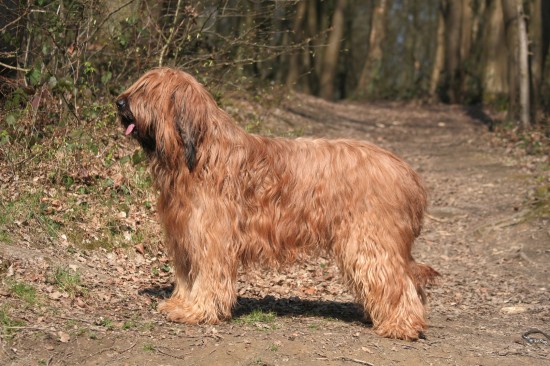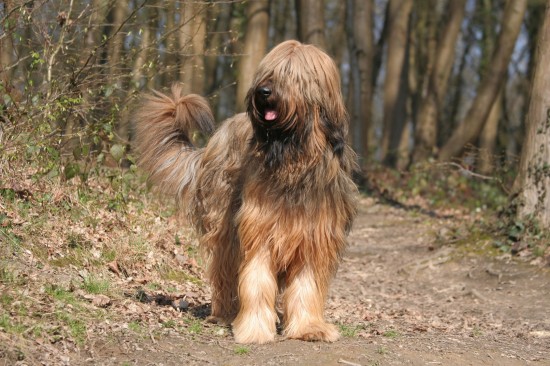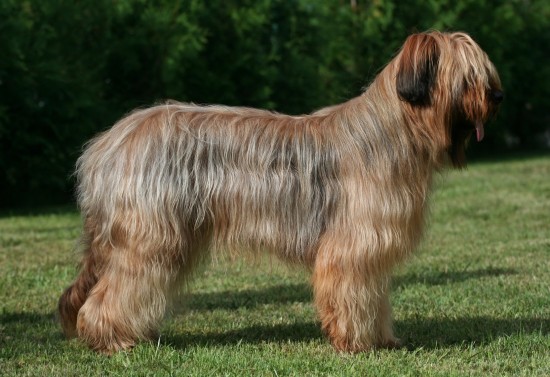



To keep a Briard's coat looking good takes a bit of commitment and regular grooming. The key to keeping on top of things is to carefully and meticulously brush your pet at least once or even twice a week. By setting up frequent grooming sessions you effectively lighten the load and it takes away the need to bath a dog which can be challenging to say the least especially with a dog that boasts a coat like the Briard.
Another advantage of regularly grooming your Briard is that you prevent any tangles and mats from forming which can prove very hard for even a skilled professional groomer to take out without damaging your pet's coat.
These lovely looking dogs boast a coat which can only be described as that of a "goat". In short, this means they are pretty easy maintenance. Their hair tends to be on the coarse site although smooth to the touch and it should fall as even locks with a natural parting on their heads, necks and all the way along their backs.
However, some Briards boast a much coarser coat which tend to be harder for owners to keep looking good. The reason being they tend to fluff up and are prone to tangle more easily. Briards that are bathed far too often have a fluffy coat which is as a result of all the valuable and natural oils being washed out of it. The result is "fly-away" hair that mats all too quickly. With this said, a lighter textured coat is also thought to be genetically inherited in many dogs from their parents.
The breed boasts a double coat with the outer being typically around six of more inches in length at a mature dog's shoulder. Outer coats don't tend to shed and grows that much slower than the undercoat. It's important to bear in mind that if the outer guard hair is damaged in any way, cut or pulled out, the hair grows back extremely slowly and this is especially the case around a dog's tail and ears.
Their under coat is a lot softer and shorter being only around 3 to 5 inches in length and it is this that sheds from time to time. It also tends to cling to the longer guard hair which as a result causes knots and tangles. Regular brushing helps prevent this from happening and stops the coat from becoming felted.
It's important for Briards to be groomed at an early age so they get used to the tools and the routine of being brushed. This also means they get used to being touched in areas that are more sensitive namely around their eyes, mouths, ears and underbellies. If also means they get used to having their paws examined and their claws checked which is important in any dog, but more especially in the larger breeds that can be harder to handle when fully mature.
You don't need that many grooming tools to keep your dog's coat in good condition, but it is always better to buy good quality products that will stand the tests of time. You will only need to invest in the following:
Placing a puppy on a table makes life a lot easier for you and your pet when you groom them. However, a young dog should never be left unattended when they are on a table because the temptation to jump off is just too great and they may well end up injuring themselves quite seriously if they do.
Once you have got them used to being on a table, the next step is to teach them to lie quietly on their sides which makes your life even easier when you brush them. A dog that's lying on their side makes it so much easier to check their paws, trim their claws or cut back the hair that grows between their paw pads.
It's a good idea to set up a routine and with Briards it's best to begin by brushing their feet and then up their legs working on small sections at a time. Any tangles need to be gently pulled apart using your fingers. You should untangle the outside of the knot and work your way down to your dog's skin rather than the other way around which could pull on the hair making it more painful for your pet to cope with.
It's very important to brush through both the outer and the under coat so you get right down to the skin because this is the only way you'll remove all the loose hair that might be caught in the guard hairs. Once you have untangled a knot it's best to use the wide toothed comb to finish the job working from the outside inwards until you get to the skin.
Having your dog lie on their side also makes it that much easier to brush their more sensitive underbellies which you should do using the bristle brush being extra careful around their elbows where the hair tends to be a lot thinner and therefore more prone to knot. Other sensitive parts include the insides of their back legs and around their privates.
When it comes to grooming your dog's chest and head, it is far easier to have them in the sitting position. For young puppies, this is a great education for them because not only are you teaching them the "sit" command, but you are also teaching them to "stay" too.
The most sensitive parts of your dog's head are around their beard and muzzle. You need to be extra gentle when you brush these areas which tend to get more knotted because food gets stuck in your dog's beard and moisture from drinking water doesn't help either.
If you find their beard is very messy and full of knots, it's best to wash it before attempting to comb it out. You should use a dog specific shampoo and avoid any "human" shampoos which are not PH balanced for use on our canine friends.
It's important to brush behind your dog's ears and down the side of their necks before grooming in-between their front legs being extra careful under the elbows where the hair tends to be that much finer and which therefore tangles more easily.
You need to have your dog standing up when you groom their rear ends and pay particular attention to their tails which many dogs don't like having brushed. You also need to be very careful around their "privates" and if you do find any knots, it's best to gently trim these away for hygiene reasons. All knots and tangles need to be trimmed away around your dog's back-end because it prevents the area from becoming soiled and therefore a bit smelly.
The key to keeping a Briard's coat looking good is to set up a frequent grooming routine which means a thorough brush at least once or twice a week. This makes life a lot easier and each session should be that much quicker to complete. It also means you won't have to bath your dog as frequently which for a dog with a coat like the Briard can be pretty challenging.
Copyright © 2005-2016 Pet Information All Rights Reserved
Contact us: www162date@outlook.com